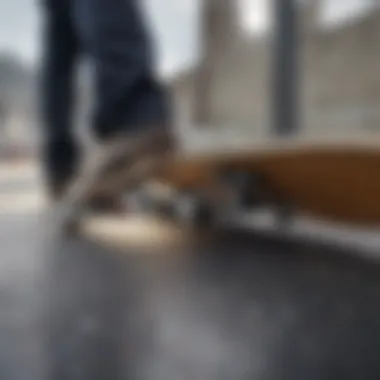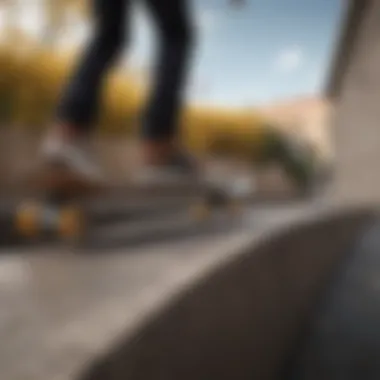Understanding Skateboard Risers: Types and Benefits


Intro
Skateboarding is not merely a hobby; it's a culture, an expression of individualism that thrived through decades of evolution. Among the myriad components that define the skateboarding experience, skateboard risers often fade into the background. Yet, they play a silent but pivotal role in enhancing performance and ensuring safety. Understanding their functionality, types, and impact can elevate your riding experience, whether you're a novice eager to learn or a seasoned rider looking to fine-tune your setup.
With an array of risers available, each designed for specific styles and needs, it’s essential to delve into their materials and installation methods. This guide aims to unravel the complexities surrounding skateboard risers, shedding light on how they can affect dynamics on the board and ultimately the rider's performance.
By the end of this article, you'll possess a comprehensive understanding of the importance of risers, enabling you to make informed decisions that maximize both safety and enjoyment while cruising or carving up the skatepark. Let's kick things off by exploring the broader world of extreme sports.
Prologue to Skateboard Risers
Skateboarding, a sport that thrives on creativity and skill, has its fair share of components that can make or break the experience. Among these components are skateboard risers, often overlooked but crucial for achieving the right setup. Understanding skateboard risers isn't just about knowing their existence; it’s about recognizing how they influence every ride you take.
Definition of Skateboard Risers
Skateboard risers are pads that are placed between the skateboard deck and the trucks. Their primary function is to elevate the trucks above the deck, allowing for increased clearance between the wheels and the deck. You might think of them like the unsung heroes of your board, doing a lot of behind-the-scenes work. Typically made from materials like plastic or rubber, risers come in various heights and thicknesses, giving skateboarders the flexibility to customize their rides based on their preferences and skills.
Importance of Risers in Skateboarding
Risers serve multiple purposes that are essential to a skateboard’s performance and rider safety.
- Increased Clearance: They prevent wheel bite, which occurs when the wheel touches the board during a hard turn. Wheel bite can lead to sudden stops and, potentially, dangerous falls.
- Shock Absorption: Riding on rough surfaces can be jarring. Risers act as a buffer, absorbing some of that impact and making for a smoother ride. This is especially helpful for those who enjoy tricks and jumping, as it helps protect both the board and the rider’s joints.
- Flexibility in Setup: For skateboarders who switch between different styles—from cruising to technical tricks—having the option to adjust the riser height means they can easily tailor their setup to fit their preferred riding style.
In summary, understanding skateboard risers provides insight into the subtleties of setup that can enhance both performance and safety. Whether you’re just starting or you’ve been riding since before your first fall, there's always something new to learn about how every component of your skateboard interacts with your riding style.
Components of a Skateboard
Understanding the components of a skateboard is fundamental for anyone looking to optimize their riding experience. Each part serves a specific purpose, contributing to the overall functionality, stability, and performance of the board. The integration of skateboard risers into this framework enhances their significance. Without a proper grasp of what materials and parts form a complete skateboard, it’s hard to appreciate the role risers play.
Overview of Skateboard Parts
A skateboard is made up of several key components that work in harmony:
- Deck: This is the flat board where the rider stands. Made from layers of laminate wood, composite materials, or even plastic, the board’s quality affects both flexibility and durability.
- Trucks: The metal components that attach the wheels to the deck. They allow the rider to turn, and they come in varied widths and strengths. The right trucks ensure efficient energy transfer and stability.
- Wheels: Typically made from urethane, wheels vary in hardness and diameter. Softer wheels are better for gripping on rough surfaces while harder wheels allow for faster rides on smooth pavement.
- Bearings: Small metal rings that fit inside the wheels. Quality bearings minimize friction, enabling a smoother roll and greater speed.
- Grip Tape: A textured adhesive layer on the top of the deck. This helps the rider maintain their footing while performing tricks.
Each of these components impacts how the skateboard performs and feels. The combination of a well-made deck, sturdy trucks, and quality wheels means a more enjoyable ride. Adding risers changes how these elements fit together, affecting the overall dynamics of the board.
Role of the Deck and Trucks
The deck and trucks form the core of any skateboard. It’s essential to understand their intertwining roles:
- Deck's Purpose: It provides the surface for trick execution and riding. A deck’s width and length can determine how comfortable and effective it is for different skating styles.
- Trucks' Functionality: These components are vital for steering. They come with a kingpin, that facilitates turning, and the height plays a pivotal role in the overall setup. Higher trucks allow a rider more stability at high speeds but may lessen maneuverability.
- Risers' Impact: Introducing risers extends the height between the deck and the trucks. This adjustment facilitates better clearance for larger wheels, reducing the risk of wheel bite, which can be a significant concern during sharp turns or tricks. It also gives riders additional room for shock absorption, improving overall ride quality.
Understanding how the deck and trucks interact opens up insights into how risers can modify their relationship. When making choices about risers, consider what kind of riding you aim to achieve. Not every skater needs the same setup; this is where personal preference plays a crucial role.
Types of Skateboard Risers
When it comes to optimizing your ride, understanding the types of skateboard risers is crucial. Each type addresses specific concerns ranging from shock absorption to wheel clearance. Choosing the right riser can significantly enhance your overall skating experience, so let’s break down the different varieties and what they bring to the table.
Standard Risers


Standard risers are basically the bread and butter of skateboard setups. They typically come in a more rigid build, designed to create space between the board and the trucks. This space can be crucial for skaters looking to avoid that dreaded wheel bite, a situation that happens when the wheels touch the board while turning sharply. Additionally, standard risers unlock the potential for a wider turning radius.
Typically made from durable plastic, standard risers are often lightweight, allowing skaters to maintain speed without dragging extra weight. Some riders swear by them for smoother landings and better control. They’re an ideal choice for beginners and those upgrading their gear without diving into more specialized options.
Shock Pads
If you're all about that comfort ride, shock pads could be your golden ticket. These are a step up from standard risers, with a design focusing on absorbing shock during landings. They’re often made from softer materials like foam or rubber, which helps to minimize the impact on your knees and ankles. This is especially vital for skaters who frequent skate parks or enjoy vert ramps.
Now, here’s something you gotta know: shock pads can alter the feel of your ride. They may soften your board's responsiveness since they introduce some give. For those who value cushy landings and softer rides—especially after a harsh drop or trick—shock pads are a go-to.
“Choosing the right risers can really turn a good skate session into a fantastic one.”
Rubber Risers
Rubber risers are yet another option that’s gaining popularity among skaters craving more grip and shock absorption. The flexibility of rubber allows for a bit of give while still supporting the weight of the board and rider, effectively reducing vibrations that can cause hand fatigue on long rides. They can also help grip the deck, which appeals to riders looking for stability and traction during tricks.
One of the things that set rubber risers apart is their durability. They can withstand wear and tear in harsher conditions, whether you're skating on rough terrain or grinding through urban environments. Plus, if you find yourself hitting bumps often, rubber risers will certainly cushion your ride more than their plastic counterparts.
Materials Used in Skateboard Risers
Risers are pivotal components in skateboarding, significantly influencing how a skateboard rides. The materials used in the construction of risers not only dictate performance but also impact durability and rider comfort. A comprehensive understanding of these materials is crucial for skaters who want to optimize their setup for performance. Each type of material offers distinct benefits and considerations, which can substantially alter the overall riding experience.
Plastic Risers
Plastic risers have become a popular choice for both novice and seasoned skaters due to their lightweight nature and affordability. Made usually from high-grade polycarbonate or other durable plastics, they provide decent clearance without adding much weight to the skateboard.
- Advantages:
- Cost-effective: Plastic risers are typically cheaper than their metal counterparts, making them a practical choice for budget-conscious skaters.
- Lightweight: The reduced weight can be an advantage for skips who prefer an agile setup.
- Variety of heights: They come in various heights, ensuring skaters can tailor their setup.
However, they may not absorb shock as effectively as other materials, which could be a deal-breaker for those constantly tackling rough terrains or performing tricks. This leads to another consideration for riding style.
Metal Risers
Metal risers, often crafted from aluminum or similar alloys, offer a more robust option for high-performance skateboards. They typically last longer under heavy use and are less likely to crack or warp over time.
- Advantages:
- Durability: Their sturdy composition often means they can withstand the rigors of street or park skating without breaking down.
- Better shock absorption: Metal risers usually absorb shocks more effectively, providing a smoother ride over rough surfaces.
- Aesthetic appeal: Many skaters appreciate the polished look of metal components, which can enhance the board’s overall design.
On the flip side, the added weight might not be ideal for everyone, especially for those who lean towards lighter setups. Moreover, they tend to be pricier, which could deter beginners.
Foam and Rubber
Foam and rubber risers offer a unique alternative, often tapering towards skaters looking for enhanced cushioning and grip. They serve as shock absorbers and can be particularly beneficial in certain riding conditions.
- Advantages:
- Shock absorption: Foam provides excellent cushioning, mitigating impacts during tricks and landing.
- Grip: Rubber variations can help prevent the skateboard from sliding around on the riser boltheads, contributing to overall stability.
- Flexibility: A softer material can allow for some flexibility in board dynamics, aiding in smooth transitions.
Nonetheless, these materials may wear down quicker than plastic or metal, necessitating more frequent replacements. Also, their lower hardness means they might not deliver the same level of support as firmer risers.


"Selecting the right riser material is an essential aspect of customizing your skateboard to fit your unique riding style and preferences."
Choosing the appropriate material for skateboard risers directly affects performance, durability, and comfort. Depending on individual preferences and riding styles, a specific material may prove to be the game-changer in an athlete's experience, whether through enhancing shock absorption, reducing weight, or providing robust performance.
Benefits of Using Risers
The significance of skateboard risers cannot be overstated. They serve multiple purposes, making them essential components for any skater aiming for both performance and safety. Understanding these benefits is crucial for beginners and seasoned riders alike, as the right riser choice can drastically enhance the overall experience on the board. Here are a few key advantages of using skateboard risers:
Increased Clearance
One of the initial advantages you’ll notice with risers is the increased clearance they provide. This extra height helps create a gap between the skateboard deck and the wheels. The primary reason for wanting this added space is to prevent what’s known as wheel bite. Imagine that moment—you're zipping down the street, performing your best trick, only to have the wheels hit the deck. It’s a nasty surprise, and one that can send you tumbling.
By adding risers, you lessen the chance of this occurring. Depending on the thickness of the risers, you might even find the added boost gives you some extra freedom to customize your setup further, allowing for larger wheels without compromising safety.
Reduced Wheel Bite
Reduced wheel bite is another critical benefit that comes hand-in-hand with using risers. When the wheels make contact with the underside of the board while turning or pushing hard, it can lead to abrupt stops and falls. This phenomenon is particularly more common with tighter turns, where the angle can be quite sharp.
Many skaters have probably experienced wheel bite at some point. It generally feels like a heart-stopping moment, especially for those attempting more extreme maneuvers. By opting for risers, you can angle your trucks differently without worrying about twist and turns leading to mishaps. This feature can allow for more aggressive riding styles without too much risk of hitting the wheels on the deck.
Enhanced Shock Absorption
The enhanced shock absorption is perhaps what many skaters hope to gain with risers. When cruising or hitting obstacles, shock can travel through the deck and into your feet. Over time, this can be taxing on your body. Risers—especially the thicker ones—can help absorb some of that impact, providing a smoother ride. Coupled with other high-quality skateboard components, risers can make a world of difference in the level of comfort experienced.
Even if you’re not deliberately trying to pull off big tricks, the everyday grind can wear down your legs and joints. By choosing risers that offer cushioning properties, you’re less likely to feel the impact from rough surfaces, which could transform your riding into a more enjoyable experience over time.
Remember: The right choice in risers can lead to greater overall control and stability, vital elements to mastering both basic and advanced skateboarding techniques.
Choosing the Right Riser Height
Finding the right riser height is crucial for any skateboarder aiming to elevate their tricks, enhance comfort, and boost stability on the board. Essentially, the height of the risers can significantly impact the overall riding experience, influencing everything from board feel to the ability to pull off complex maneuvers. The perfect riser height contributes to a seamless connection between the skateboarder and the terrain, ensuring a smoother ride.
Factors Influencing Riser Height
When determining what riser height to go with, several factors come into play. These considerations can make all the difference in your performance and comfort:
- Wheel Size: Larger wheels often require taller risers to avoid wheel bite. If your wheels are big, you’ll want to think about going higher than if you're using smaller ones.
- Skateboard Type: Different types of skateboards are designed for various riding styles. For instance, a street skateboard might benefit from lower risers, while a longboard rider might prefer them higher for improved stability.
- Riding Style: Aggressive riding might call for a different setup than cruising or commuting. It’s smart to evaluate your typical maneuvers.
- Terrain: If you frequently ride on rough surfaces, a slightly higher riser can absorb impacts better and allow for more clearance.
It's worth noting that experimenting with riser heights can lead to discovering the ideal arrangement, tailored to individual preferences.
Personal Riding Style Considerations
Your unique riding style plays an exceptionally pivotal role in choosing riser heights. Here are some pointers to think about:
- Trick Focus: If you're all about those tricks, you might prefer a moderate riser. This ensures more responsiveness. A lower height can give a more natural feel during flips and landings.
- Speed Enthusiast: Riders who emphasize high-speed tricks often benefit from taller risers, as they enhance stability at those elevated velocities.
- Comfort: Picking the right height can also come down to personal comfort. An off-height riser can lead to fatigue, so ensuring you feel stable and can maneuver freely is key.
- Injury History: If you've had previous injuries, you may want to consider a height that provides better shock absorption and stability.
"Choosing the right riser height can mean the difference between conquering the park or having your board get the best of you."
In summary, a thoughtful approach to selecting riser height can profoundly enhance both the ability to perform tricks and overall riding enjoyment. When these heights are optimized, skaters can expect improved board control and safety on their journeys, making them an integral part of the setup.


Installation and Maintenance of Risers
Installing and maintaining skateboard risers might not be the first thing that comes to mind when considering optimal performance, but it plays a crucial role for both seasoned riders and rookies. Risers, though often taken for granted, affect how a skateboard handles, its overall longevity, and even your safety. So, let’s dive into how you can set up and care for your skateboard risers effectively.
Step-by-Step Installation Guide
Installing risers is not rocket science, but there are a few steps you need to follow to do it right:
- Gather Your Tools: You’ll need a skate tool or a wrench, bolts, and of course, the risers.
- Remove the Trucks: Loosen the bolts that secure the trucks to the skateboard deck and carefully lift them off. Be cautious not to lose any bolts.
- Position the Risers: Place the risers on the mounting area on top of the skateboard deck. Ensure they align with the trucks perfectly.
- Attach the Trucks: Line up the holes in your risers with the trucks. Now, put the trucks back onto the board, securing them with the bolts you previously removed.
- Tighten the Bolts: Use your tool to tighten the bolts securely but not overly tight that they strip the threads. You want a firm fit but still some room for the parts to flex during use.
- Test Your Setup: Before hitting the skatepark, push your board around to check for any unusual wobble or noise. If everything feels good, you’re ready to skate!
Regular Maintenance Tips
Just like any other part of your skateboard, risers require regular checks to ensure they remain effective. Here are some handy tips:
- Check for Wear and Tear: The rubber or plastic can wear down over time. Inspect them regularly, especially after heavy use.
- Tighten Bolts Periodically: Over time, bolts may loosen due to vibrations and impacts. It’s good practice to revisit these screws to keep everything snug.
- Keep Them Clean: Dirt and grime can build up, affecting performance. Wipe down with a damp cloth often—especially after skating in dusty conditions.
- Replace When Necessary: If you notice cracks or breakage in the risers, replace them straight away. Riding on compromised equipment can be hazardous.
"Regular maintenance significantly contributes to a smoother and safer skateboarding experience."
Engaging in these practices not only enhances the quality of your ride but also prolongs the life of your skateboard components.
By being diligent with installation and maintenance, riders can make the most of their skateboard risers, ensuring that they live up to their potential—and that means more joy on your rides.
Impact of Risers on Board Performance
When it comes to skateboarding, every element plays a role in how the board responds, performs, and, most importantly, how it feels beneath your feet. Riveting as it is, skateboard risers hold a crucial place in this equation. Their influence extends beyond mere height adjustments; they fundamentally affect how a skater interacts with the board during movement.
Turning and Maneuverability
Risers have a direct hand in the board’s turning capabilities. By raising the trucks off the deck slightly, they allow for an improved turning radius. This alteration means more agile maneuvering, essential for street skating or trick execution. If you’ve ever felt that unsettling wobble when leaning into a turn, you know how pivotal stability is. A well-placed riser can ease this, permitting you to carve tighter and with greater confidence. Just imagine rolling up to a sharp corner with such finesse that you practically glide through rather than wrestle with your board.
Additionally, the shape and style of the risers also matter. Softer rubber risers, for example, might provide an even more forgiving ride. They can cushion the deck during those wild turns, giving a skater the ability to maintain their balance more effectively, especially when going fast. It’s a delicate dance between body weight distribution and the board’s setup, with risers being key players in this performance ensemble.
Stability at High Speeds
Speed junkies know that feeling of soaring down a hill or racing through a park. But with speed must come control; there’s only so far a board can be pushed before it feels unstable. This is where the appropriate riser height shines. A higher riser can help balance a skateboarder’s weight, distributing forces more evenly when unexpected bumps or cracks arise on the pavement. This, in turn, lulls the skater into calmness during thrills.
Moreover, a longer wheel base often results from using risers, which enhances stability. At speed, this makes a world of difference. Cyclists brag about their bikes’ aerodynamics; for skaters, it’s about how well your board hugs the ground. Experience with gear makes one wiser; adjusting risers can be the difference between a troublesome ride and the euphoria of gliding downhill.
"Risers may seem like small potatoes, but they can transform your ride, especially at breakneck speeds, from jittery to smooth."
Finale
In summary, the impact of risers on board performance cannot be understated. They fine-tune how a skateboard reacts to both sharp turns and high-speed rides. Understanding their role pushes a skater towards maximizing their performance, leading to a more enjoyable and safer experience on the board. Thus, every skater, from the keen beginner to the seasoned pro, should carefully consider riser height and type to achieve the desired balance of agility and stability.
Closure
In closing, the discussion around skateboard risers underscores their pivotal role in the performance and safety of skateboarding. By understanding the types of risers available, their construction materials, and the benefits each offers, skaters can make informed decisions that directly impact their riding experience. It's clear that the right risers can enhance maneuverability, provide stability at high speeds, and assist in mitigating wheel bite—a common challenge for many shredders on the streets or in the parks.
Final Thoughts on Skateboard Risers
Skateboard risers are often an overlooked component, but they hold significance for both casual riders and dedicated athletes alike. With various options like standard risers, shock pads, and rubber types, skaters can fine-tune their setups to match their unique styles and preferences. Whether you're searching for more flexibility during tricks or a cushioned landing, understanding how these components interact with your deck and trucks can enhance your overall skateboarding outcome. As with many things in skateboarding, it's all about the right fit—choosing risers that cater to personal preferences can elevate your performance.
Encouragement for Optimal Setup
Realizing the full potential of your skateboard setup means taking risers into serious consideration. Don’t shy away from experimenting with different heights and materials. Each change can yield distinct results, impacting your ride's feel and handling. Remember to focus not just on aesthetic choices or brand names but on what aligns best with your riding style. Investigating resources like forums on reddit.com or informative articles on en.wikipedia.org can provide further viewpoints and testimonials about various riser setups.
Your setup is a true extension of your skateboard persona; so invest time into finding the perfect risers. Take the plunge and adapt your board to fit your riding needs, and witness the benefits unfold. The right risers don’t just change the dynamics of a board—they can transform your whole skating experience.







